2023 NISSAN LEAF Vehicle information display warning
[x] Cancel search: Vehicle information display warningPage 17 of 612
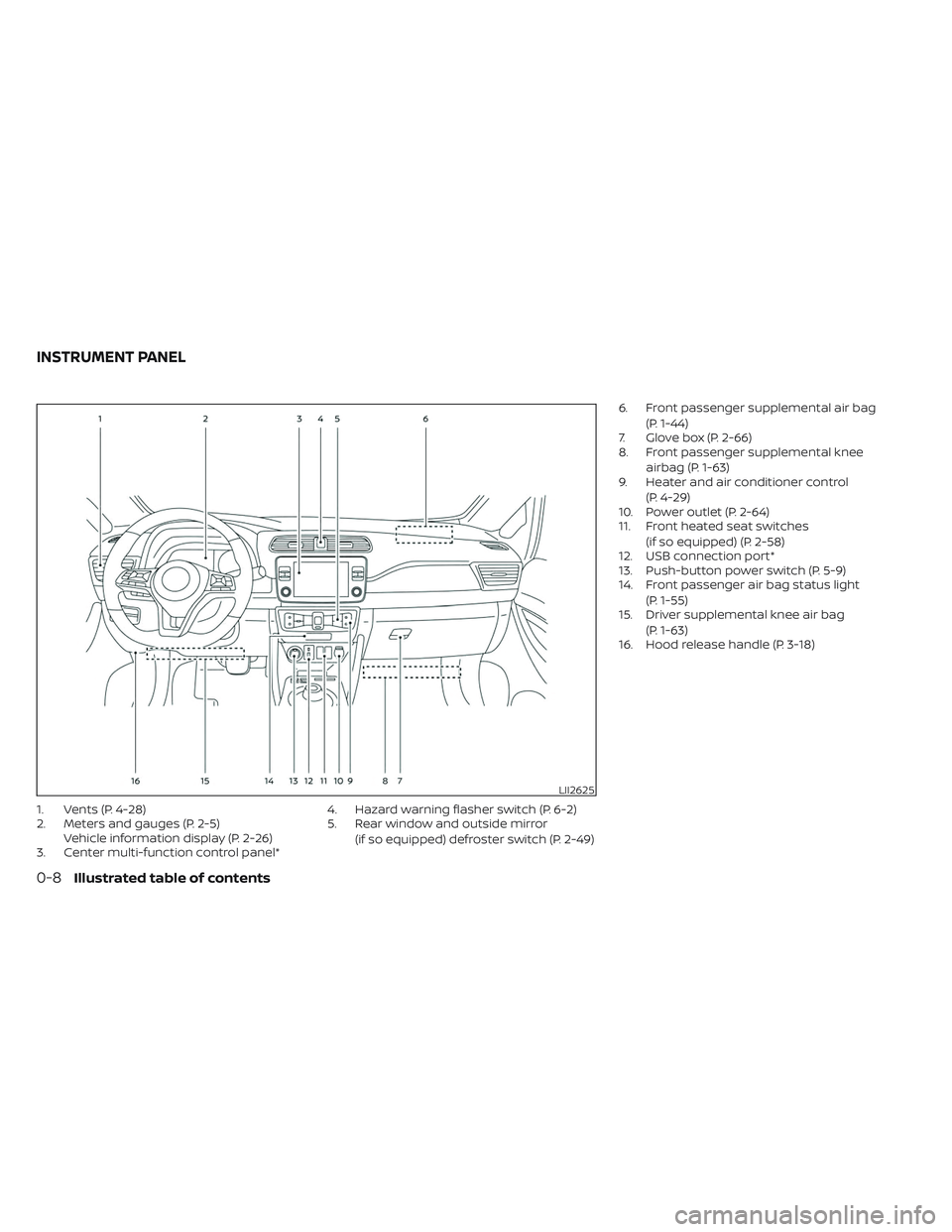
1. Vents (P. 4-28)
2. Meters and gauges (P. 2-5)Vehicle information display (P. 2-26)
3. Center multi-function control panel* 4. Hazard warning flasher switch (P. 6-2)
5. Rear window and outside mirror
(if so equipped) defroster switch (P. 2-49) 6. Front passenger supplemental air bag
(P. 1-44)
7. Glove box (P. 2-66)
8. Front passenger supplemental knee
airbag (P. 1-63)
9. Heater and air conditioner control
(P. 4-29)
10. Power outlet (P. 2-64)
11. Front heated seat switches
(if so equipped) (P. 2-58)
12. USB connection port*
13. Push-button power switch (P. 5-9)
14. Front passenger air bag status light
(P. 1-55)
15. Driver supplemental knee air bag
(P. 1-63)
16. Hood release handle (P. 3-18)
LII2625
INSTRUMENT PANEL
0-8Illustrated table of contents
Page 18 of 612
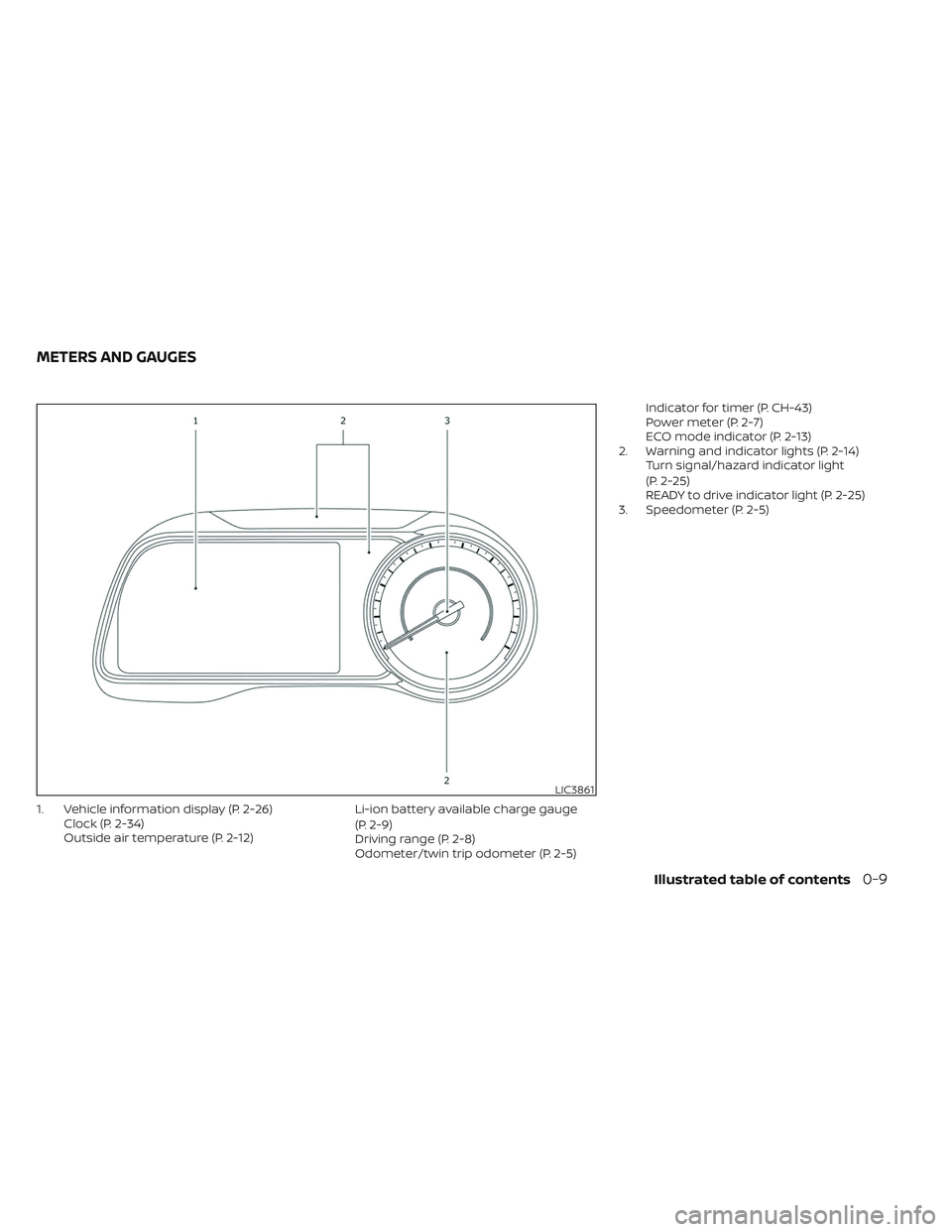
1. Vehicle information display (P. 2-26)Clock (P. 2-34)
Outside air temperature (P. 2-12) Li-ion battery available charge gauge
(P. 2-9)
Driving range (P. 2-8)
Odometer/twin trip odometer (P. 2-5)Indicator for timer (P. CH-43)
Power meter (P. 2-7)
ECO mode indicator (P. 2-13)
2. Warning and indicator lights (P. 2-14) Turn signal/hazard indicator light
(P. 2-25)
READY to drive indicator light (P. 2-25)
3. Speedometer (P. 2-5)
LIC3861
METERS AND GAUGES
Illustrated table of contents0-9
Page 26 of 612
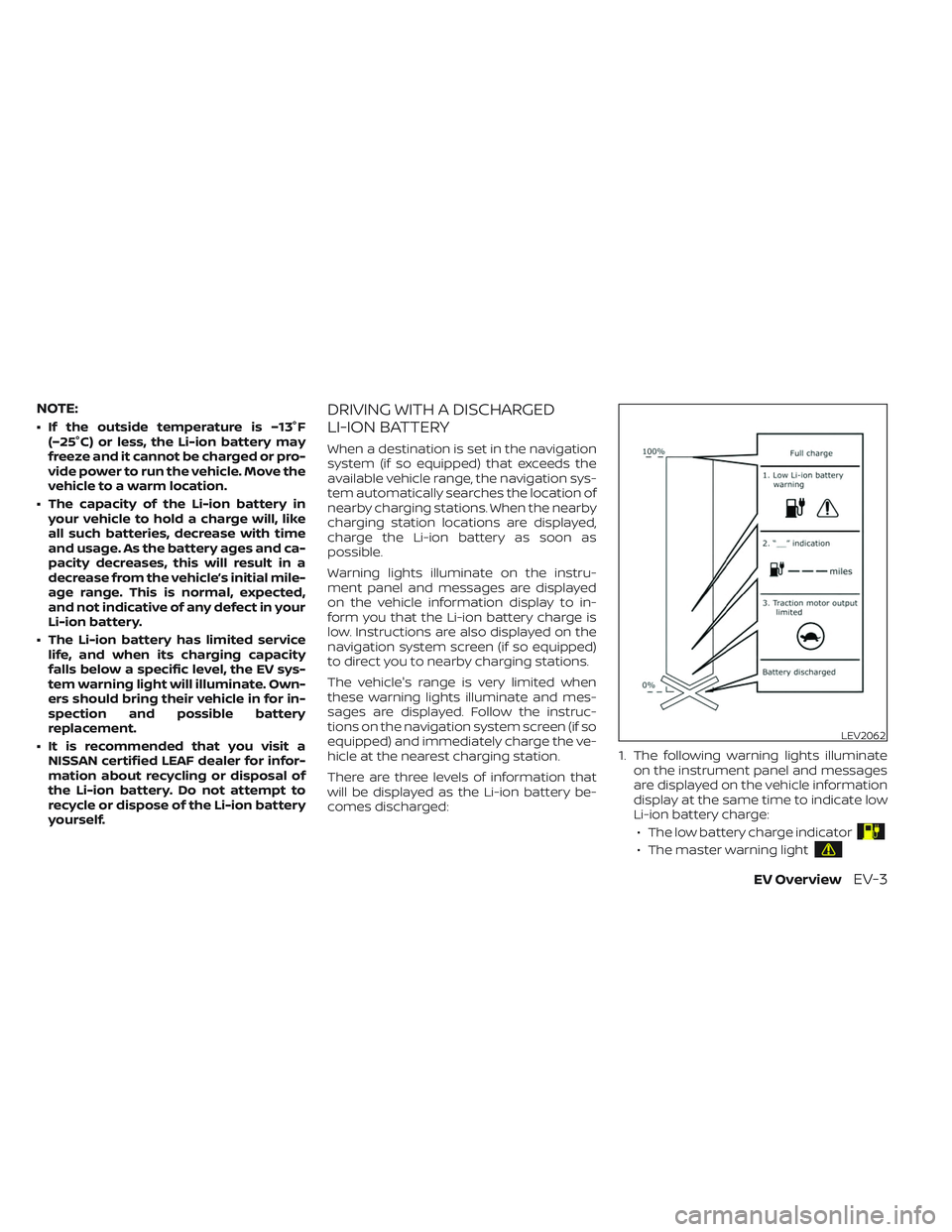
NOTE:
• If the outside temperature is −13°F(−25°C) or less, the Li-ion battery may
freeze and it cannot be charged or pro-
vide power to run the vehicle. Move the
vehicle to a warm location.
• The capacity of the Li-ion battery in your vehicle to hold a charge will, like
all such batteries, decrease with time
and usage. As the battery ages and ca-
pacity decreases, this will result in a
decrease from the vehicle’s initial mile-
age range. This is normal, expected,
and not indicative of any defect in your
Li-ion battery.
• The Li-ion battery has limited service life, and when its charging capacity
falls below a specific level, the EV sys-
tem warning light will illuminate. Own-
ers should bring their vehicle in for in-
spection and possible battery
replacement.
• It is recommended that you visit a NISSAN certified LEAF dealer for infor-
mation about recycling or disposal of
the Li-ion battery. Do not attempt to
recycle or dispose of the Li-ion battery
yourself.
DRIVING WITH A DISCHARGED
LI-ION BATTERY
When a destination is set in the navigation
system (if so equipped) that exceeds the
available vehicle range, the navigation sys-
tem automatically searches the location of
nearby charging stations. When the nearby
charging station locations are displayed,
charge the Li-ion battery as soon as
possible.
Warning lights illuminate on the instru-
ment panel and messages are displayed
on the vehicle information display to in-
form you that the Li-ion battery charge is
low. Instructions are also displayed on the
navigation system screen (if so equipped)
to direct you to nearby charging stations.
The vehicle's range is very limited when
these warning lights illuminate and mes-
sages are displayed. Follow the instruc-
tions on the navigation system screen (if so
equipped) and immediately charge the ve-
hicle at the nearest charging station.
There are three levels of information that
will be displayed as the Li-ion battery be-
comes discharged: 1. The following warning lights illuminate
on the instrument panel and messages
are displayed on the vehicle information
display at the same time to indicate low
Li-ion battery charge:
• The low battery charge indicator
• The master warning light
LEV2062
EV OverviewEV-3
Page 27 of 612

• The “Battery charge is low, Chargenow” warning message is displayed
on the vehicle information display.
• Messages are displayed on the navi- gation system screen (if so equipped).
• For additional information, see “Low battery charge indicator” (P. 2-38).
• The driving range flashes
O1.
NOTE:Due to traffic conditions, it may be dif-
ficult to get to the charging station
suggested by the navigation system
(if so equipped). If the Li-ion battery is
almost completely discharged, drive
directly to the nearest charging
station.2. If the vehicle is driven and the Li-ion bat-
tery continues to discharge, the driving
range on the instrument panel changes
to “— — —”O2.
Messages are displayed on the naviga-
tion system screen (if so equipped). For
additional information, see “Li-ion bat-
tery available charge gauge” (P. 2-9).
LEV2063LEV2064
EV-4EV Overview
Page 48 of 612
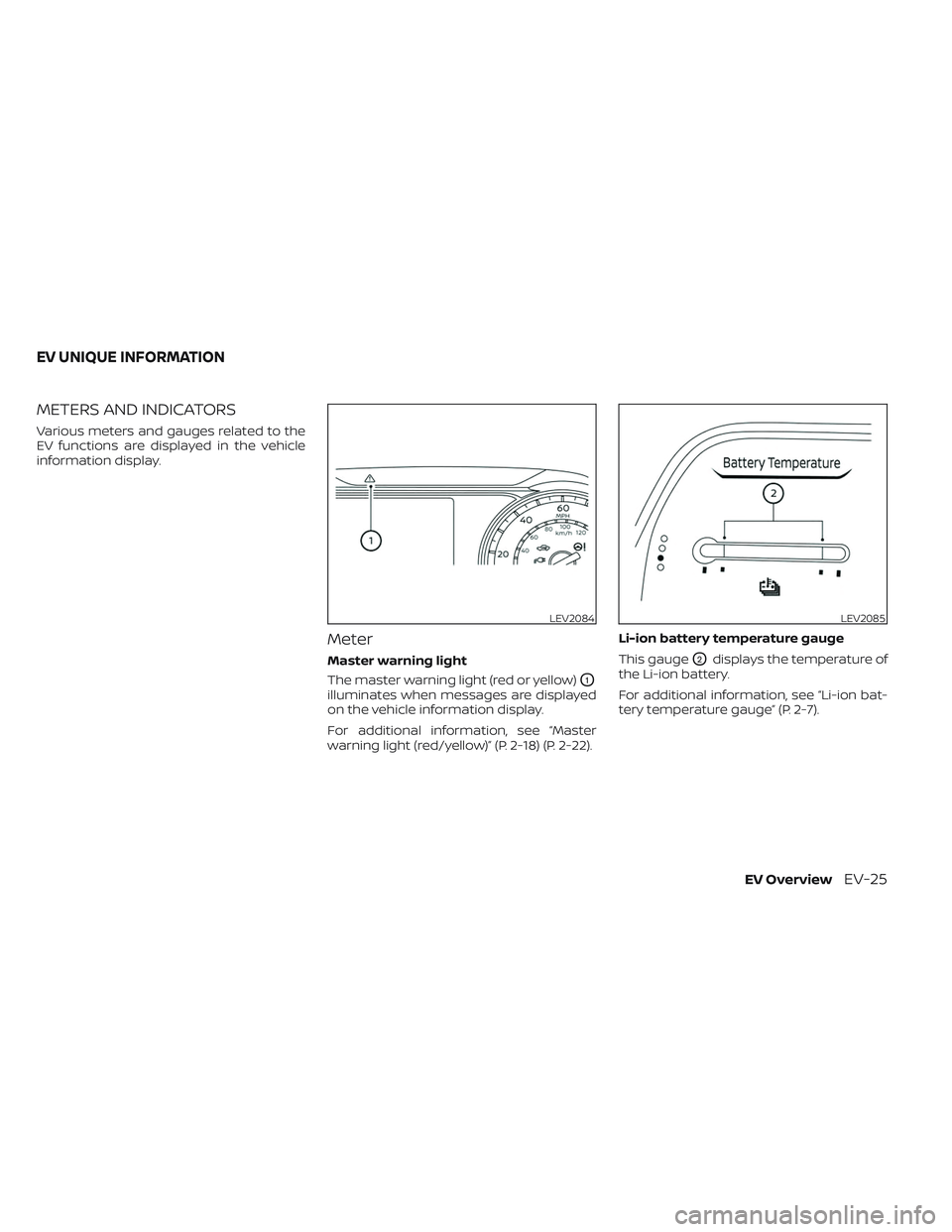
METERS AND INDICATORS
Various meters and gauges related to the
EV functions are displayed in the vehicle
information display.
Meter
Master warning light
The master warning light (red or yellow)
O1
illuminates when messages are displayed
on the vehicle information display.
For additional information, see “Master
warning light (red/yellow)” (P. 2-18) (P. 2-22).Li-ion battery temperature gauge
This gauge
O2displays the temperature of
the Li-ion battery.
For additional information, see “Li-ion bat-
tery temperature gauge” (P. 2-7).
LEV2084LEV2085
EV UNIQUE INFORMATION
EV OverviewEV-25
Page 51 of 612

The sound starts when the vehicle speed is
less than 22 mph (35 km/h) while
decelerating.
WARNING
• If the sound cannot be heard, pedes-
trians may not notice the oncoming
vehicle, which may cause an accident
resulting in serious injury or death. It
is recommended that you immedi-
ately visit a NISSAN certified LEAF
dealer for VSP system inspection.
• If the VSP system OFF warning light
illuminates while the power switch is
in the ON position, or in the READY to
drive position, it may indicate the VSP
system is not functioning properly.
Have the VSP system checked. It is
recommended that you visit a
NISSAN certified LEAF dealer for this
service. For additional information,
see “Approaching Vehicle Sound for
Pedestrians (VSP) system OFF
warning light” (P. 2-19).
NOTE:
The volume of the (VSP) sound cannot be
raised or lowered.
ELECTRIC SHIFT CONTROL
SYSTEM
This vehicle is equipped with an electric
shif t control system. This control system
has three features:
• Smooth and easy shif t lever operation.
• To place the vehicle in the P (Park) posi- tion, push the P (Park) position switch on
the shif t lever.
• The vehicle automatically applies the P (Park) position when the power switch is
placed in the OFF position.
For additional information, see “Driving the
vehicle” (P. 5-14).
LED HEADLIGHT (low beam) (if so
equipped)
This vehicle uses an LED headlight for the
headlight low beam. The LED headlight has
the following features:
• Low power consumption
• The shape is very compact.
It is recommended that you visit a NISSAN
certified LEAF dealer to replace the
headlight.
DRIVING RANGE
On the vehicle information display or navi-
gation system screen (if so equipped), you
can check the estimated distance the ve-
hicle may be driven with the available Li-ion
battery charge. For additional information,
refer to the NissanConnect® Manual.LEV2051
EV-28EV Overview
Page 60 of 612

Charging stations or V2X charging/
discharging devices using this standard
are UL certified and safe to use in the US.
While supported by NISSAN, this connector
may not become the US SAE standard. V2X
charging/discharging is possible (even
several times a day). If the battery tempera-
ture is near the red zone, in order to protect
the battery, power of the V2X charging/
discharging will be limited.
For additional information, consult a V2X
device manufacturer or a V2X charging/
discharging service provider.
Power limitation mode
This mode protects the health and opera-
tion of the vehicle's Li-ion battery. This
mode operates in certain extreme condi-
tions (heat, cold, low state of charge). Power
available to vehicle systems, including its
traction motor, is limited resulting in limited
performance, acceleration and top speed.
Charging may be automatically termi-
nated, especially with repeated quick
charging in extreme hot weather.Checking Li-ion battery charge
The three methods for checking the
amount of charge are as follows:
• Check by using the Li-ion battery avail-
able charge gauge on the vehicle infor-
mation display when the power switch is
placed in the ON position. For additional
information, see “Li-ion battery available
charge gauge” (P. 2-9) and “Low battery
charge indicator” (P. 2-38).
• Check by using an internet enabled smart phone or personal computer. For
additional information, refer to the
“NissanConnect® Manual”.
• Check by using the charging status indi- cator light. For additional information, see
“Charging status indicator lights”
(P. CH-49).
NOTE:
• During the charge operation, charge continues when the power switch is
placed in the ON position.
• The Li-ion battery cannot be charged if the quick charge connector and the
normal charge connector are con-
nected at the same time. If another
charge connector is connected mid-
charge, charging will stop. • For safety reasons, it is not possible to
switch to the READY to drive position
while a charge connector is connected.
• During charging, it is possible that the radio may be inaudible due to noise by
the electromagnetic wave.
HOW TO NORMAL CHARGE (AC
220–240 volt) BY CHARGING
DEVICE
WARNING
• If you use any medical electric de-
vices, such as an implantable cardiac
pacemaker or an implantable cardio-
vascular defibrillator, check with the
electric medical device manufac-
turer concerning the effects that
charging may have on implanted de-
vices before starting the charge op-
eration. Charging may affect the
operation.
• Be sure to follow the precautions for
using the charging device that can be
installed in your home. Failing to do
so could result in serious injury or
death.
ChargingCH-9
Page 86 of 612
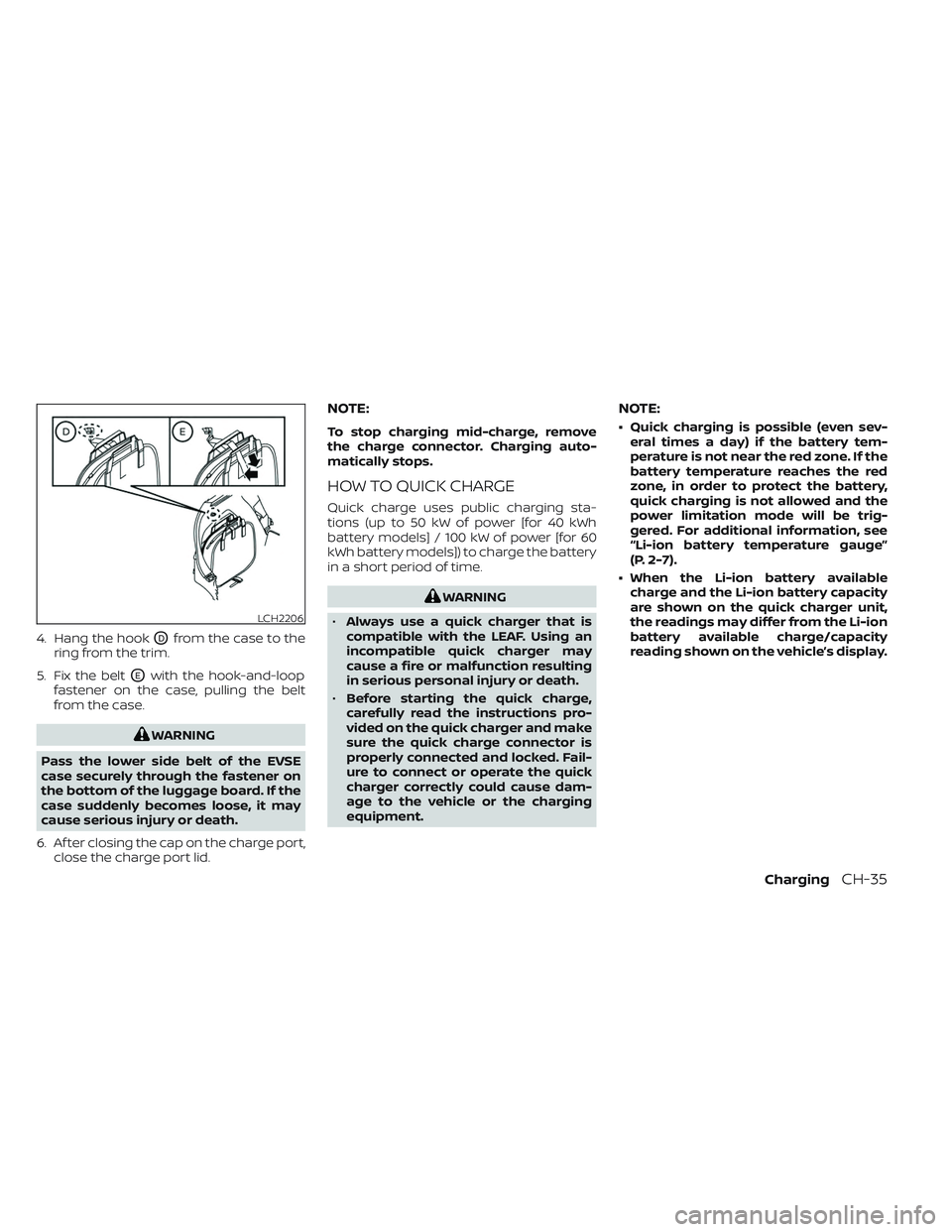
4. Hang the hookODfrom the case to the
ring from the trim.
5. Fix the belt
OEwith the hook-and-loop
fastener on the case, pulling the belt
from the case.
WARNING
Pass the lower side belt of the EVSE
case securely through the fastener on
the bottom of the luggage board. If the
case suddenly becomes loose, it may
cause serious injury or death.
6. Af ter closing the cap on the charge port, close the charge port lid.
NOTE:
To stop charging mid-charge, remove
the charge connector. Charging auto-
matically stops.
HOW TO QUICK CHARGE
Quick charge uses public charging sta-
tions (up to 50 kW of power [for 40 kWh
battery models] / 100 kW of power [for 60
kWh battery models]) to charge the battery
in a short period of time.
WARNING
• Always use a quick charger that is
compatible with the LEAF. Using an
incompatible quick charger may
cause a fire or malfunction resulting
in serious personal injury or death.
• Before starting the quick charge,
carefully read the instructions pro-
vided on the quick charger and make
sure the quick charge connector is
properly connected and locked. Fail-
ure to connect or operate the quick
charger correctly could cause dam-
age to the vehicle or the charging
equipment.
NOTE:
• Quick charging is possible (even sev- eral times a day) if the battery tem-
perature is not near the red zone. If the
battery temperature reaches the red
zone, in order to protect the battery,
quick charging is not allowed and the
power limitation mode will be trig-
gered. For additional information, see
“Li-ion battery temperature gauge”
(P. 2-7).
• When the Li-ion battery available charge and the Li-ion battery capacity
are shown on the quick charger unit,
the readings may differ from the Li-ion
battery available charge/capacity
reading shown on the vehicle’s display.
LCH2206
ChargingCH-35